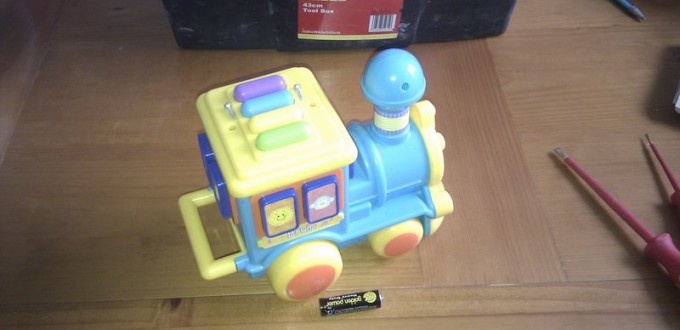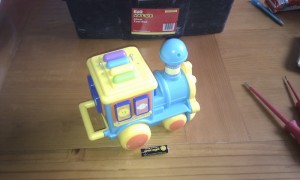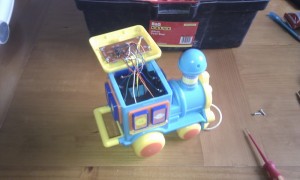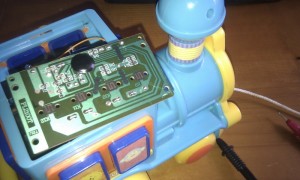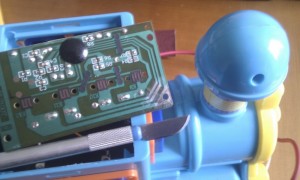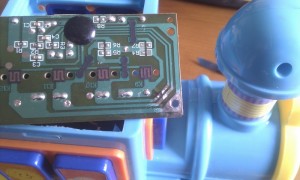Our daughter has a toy train (from ToysRUs) which she really enjoys playing with but the other day she threw it on the floor from her high chair and most of the noises it made suddenly stopped working (hmmm, was that really a bad thing?). Being the sort of person that can’t bare to see something in need of repair I decided to open it up and see if I could spot what was wrong.
This image shows the train in all it’s glory. I’ve already removed two screws from the top and one of the batteries (because the one remaining sound kept going off and it was annoying).
With some effort I was then able to remove the top of the train. This thing really isn’t built to be taken apart! There are two molded in plastic clips as well as the screws that hold the top in place. A large flat head screw driver can be used to release the clips although be warned you may well snap the top or side doing this as they are very tight. I found that even with one clip opened I couldn’t get the top off easily. It would seem the molding isn’t exactly great and there was a lip on the clip preventing easy removal. Once the top is off this is what you’ll see.
There’s a single circuit board with 12 (I hope that’s right I didn’t count) wires running to it. I wasn’t really interested in the wiring as I was pretty certain the fault would be on the board. I took out the four screws that attach the board to the top and started to have a look for problems.
The first thing I did was touch a screw driver across the button that I knew to be working to make sure I’d not damaged it further getting in (don’t forget to put the battery back in). I was, thankfully, greeted with a train noise. The “buttons” are of an interesting design I’ve not seen before. They are like two forks with their prongs intertwined. The button on top is just a conductive pad that makes a contact. After much probing around with a little multi-meter I was at a bit of a loss as to what was wrong. Everything that should have voltage had it so I was beginning to think the chip was broken although experience tells me that is unlikely.
Eventually I decided to span the probe between the positive side of the switch and the negative track just as it entered the chip…
Choo choo
That told me that the fault was either in the switches (unlikely to have the same fault in three I think) or in the track so as a last stab at figuring out what was wrong I tested the continuity of the return portion of the track for the switches. Nothing. I looked at the board more closely and that’s when I saw it, a crack running from the corner in and passing through three of the four return tracks. If you look in the photograph the fault is quite obvious (bottom right corner) because of the way the flash has caught it but just looking at the board it was almost impossible to see.
To fix the fault I carefull scraped away the varnish with a curved scalpel (I believe that would be an x-acto knife in America)
I then carefully (and somewhat badly) soldered the joint.
I imagine the soldering would be rather better if my £5 soldering iron was fitted with a more suitable tip, the one it currently has is like a large flat head screwdriver! I quickly tested the sounds all worked and then put the train back together leaving out the screw on the broken corner. I’m happy to say that after two weeks of being bashed by our youngest everything is still working so it looks like the fix is pretty strong.
